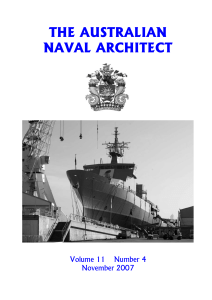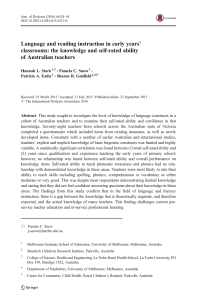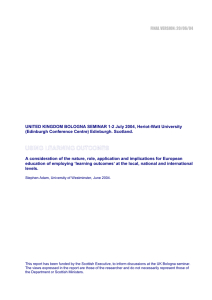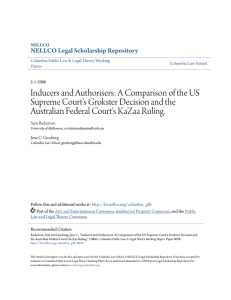Higher Education in Australia
Anuncio
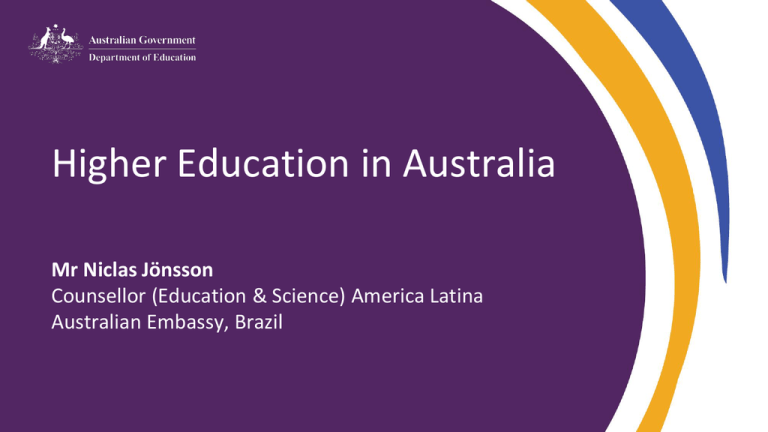
Higher Education in Australia Mr Niclas Jönsson Counsellor (Education & Science) America Latina Australian Embassy, Brazil Department of Education • Education office for Latin America established at Australian Embassy, Brasilia in October 2014 • Counsellor (Education & Science) and two staff • Responsible for the Department of Education’s engagement in Latin America • Exploring opportunities for closer cooperation between Colombia and Australia in education and training, science and research About Australia Population: 23 million Largest city: Sydney 5 million Capital city: Canberra Surface area: 7.69 mil sq kms Main language: English Australians born abroad: 28% Australian education system • Four education sectors: early childhood, schools, vocational education and training, and higher education • Education and training is shared responsibility of federal government and the eight and state and territory governments • Co-operation at the Ministerial level on education policy and planning with shared administration and financing Australian higher education at a glance (2013) • 1.31 million Australian and international students (2012: 1.25m) • 328,402 international students • Postgraduate 27%, undergraduate 73% • Female students 56% • Full-time students 70% Australian higher education at a glance (2013) • 92.5% of students enrolled with 39 public universities • 7.5% of students enrolled with 3 private universities and 96 non-university higher education institutions • Students from poorer backgrounds (low socio-economic status) increased by 7.1% to make up 17.1% of students • Growing sectors: Engineering and Related Technologies (+10.5%), Information Technology (+8.3%), Health (+7.6%) Latin American student enrolments (Sep-14) All sectors (Higher Education, Vocational Education & Training, English Language, Schools) • Brazil 19,407 (+26.2%) • Colombia 11,186 (+6.4%) • Chile 2,038 (+13.9%) • Mexico 1,951 (+21.4%) • Top-4: China 142,484; India 56,307; Vietnam 27,550; Korea 25,089 COLOMBIA Australia Colombia data snapshot YTD Enrolments, September 2013 Higher ed VET ELICOS Schools Other Total 1,265 1,626 7,539 18 65 10,513 YTD Enrolments, September 2014 Higher ed VET ELICOS Schools Other Total 1,328 1,871 7,897 21 69 11,186 Growth in enrolments (Sept 2013-14) 6.4% Endeavour Scholarships & Fellowships (2007-15) Inbound Outbound 13 0 Student mobility programs (2008-15) Inbound Outbound 7 33 Active formal agreements with Australian institutions (2014) Joint publications with Australia (2012) 63 240 Quality of higher education • 7 Australian universities in world top-100 • 19 Australian universities in world top-500 (of 39 in total) • US News Global Universities Ranking for 2015 (October 2014) • Mainly focused on university research output • Australia ranks as ninth best higher education system • #1 United States #2 Sweden #3 Canada #4 Denmark #5 Finland • (Universitas 21 Ranking 2014) Demand driven funding • 2012: introduction of demand driven system for bachelor courses at public universities • The Government now funds all domestic students accepted into eligible bachelor level courses • In 2013, 577,700 places were funded - around 23 per cent more than in 2009. • Cost of US$5 billion a year The Higher Education Contribution Scheme (HECS) • Estimated that students pay 40% of cost of education through a student contribution • Students pay between US$5,100 - US$8,500 per year • Students can delay paying their contribution through HECS • The student repays the Government through the taxation system when their income reaches US$45,000 Quality assuring higher education • TEQSA: The Tertiary Education Quality and Standards Agency (2011) • Independent national regulation and quality assurance agency • Registration of higher education institutions • Accreditation of courses • Risk based approach: based on institution’s history of scholarship, teaching and research, financial status and capacity TEQSA • National Register: source of information on the status of institutions • www.teqsa.gov.au/national-register • Registration shows the higher education institution is compliant with national standards • Institutions registered to deliver courses to international students listed on the Commonwealth Register of Institutions and Courses for Overseas Students • cricos.deewr.gov.au Australian Qualifications Framework • National policy for all qualifications across all sectors • Established in 1995, fully implemented 1999, revised 2013 • Structured by levels and qualification types • Emphasises flexibility and supports linkages and pathways between the education sectors and the labour market Australian Qualifications Framework Level 1: Certificate I Level 2: Certificate II Level 3: Certificate III Level 4: Certificate IV Level 5: Diploma Level 6: Advanced Diploma, Associate Degree Level 7: Bachelor Degree Level 8: Bachelor Honours Degree, Graduate Certificate, Graduate Diploma Level 9: Masters Degree Level 10: Doctoral Degree AQF purpose and role • Qualifications are recognised across Australia • Consistency in outcomes for each qualification type • Supports national standards in education and training • Communicates what Australian qualifications mean • Facilitates mobility of learners and workers International linkages • Two projects to align the AQF with the European Qualifications Framework and the New Zealand Qualifications Framework • Development of the ASEAN Qualifications Reference Framework supported by Australia and New Zealand • Framework to support mobility in 10 south-east Asian countries • Development of joint Colombia and Australia education work plan Gracias!
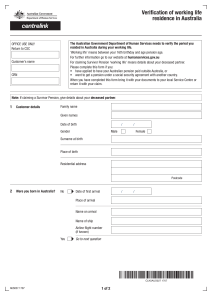
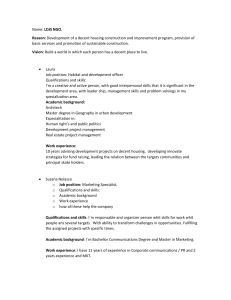
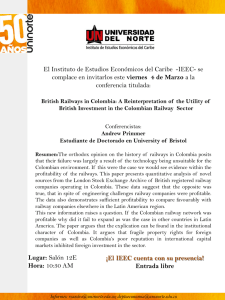
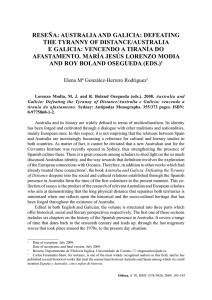
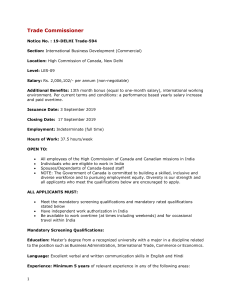
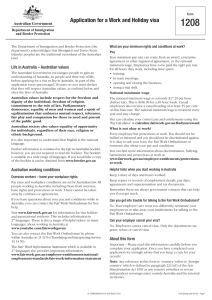
![[Click here and type address] - European University Association](http://s2.studylib.es/store/data/006496683_1-5f05726b0744802e0a7e277ba989ca8c-300x300.png)
